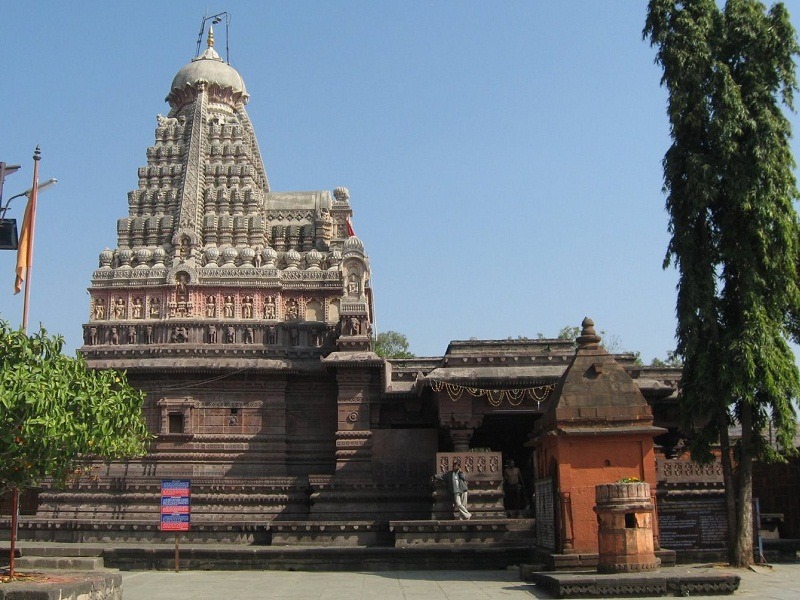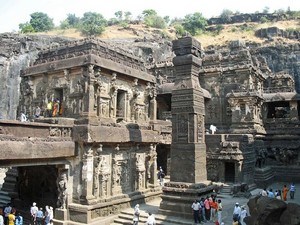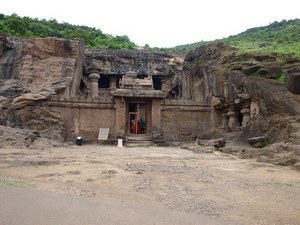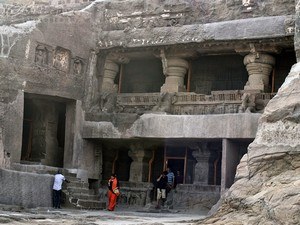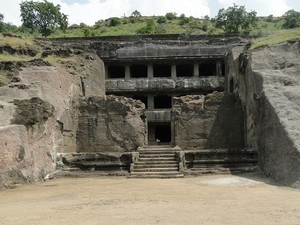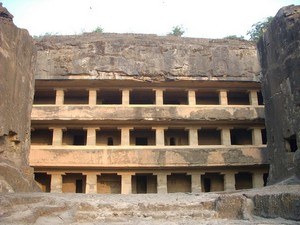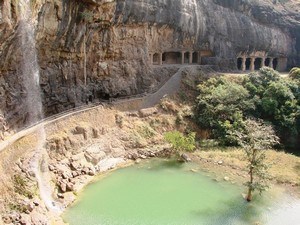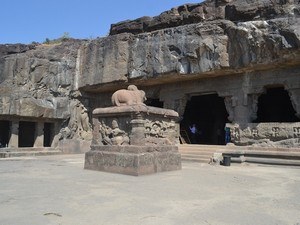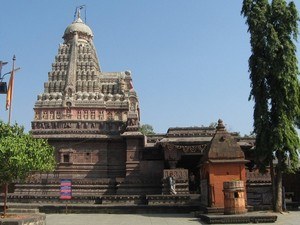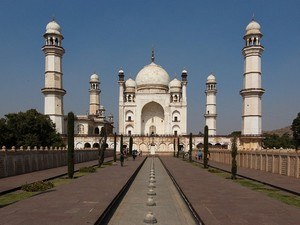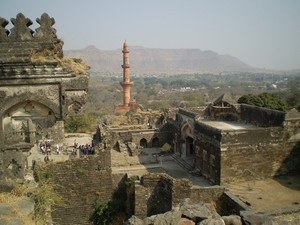Ghrushneshwar / Grishneshwar Jyotirlinga Temple, Ellora Caves - Timings, Festivals, History, Darshan, Pooja Timings
Photo Credit: Flickr
 #10 of 22 Places to Visit in Ellora Caves
#10 of 22 Places to Visit in Ellora Caves
 Distance (From Ellora Bus Station): 1 Kms
Distance (From Ellora Bus Station): 1 Kms
 Trip Duration (Including Travel): 30 Mins - 1 Hr
Trip Duration (Including Travel): 30 Mins - 1 Hr
 Place Location: Near Ellora Caves
Place Location: Near Ellora Caves
 Transportation Options: Bus / Cab / Walk/Trek
Transportation Options: Bus / Cab / Walk/Trek
 Travel Tips: None
Travel Tips: None
About Ghrushneshwar/Grishneshwar Temple
At a distance of 1 Km from Ellora Caves, and 29 Km from Aurangabad, Grishneshwar or Ghrushneshwar Jyotirlinga Temple is a revered Hindu temple located at Verul village in the Aurangabad district of Maharashtra. Dedicated to Lord Shiva, the temple is an important pilgrimage site in the Shaiva tradition of Hinduism, which considers it as the last or twelfth Jyotirlinga (linga of light) in India, and among the 5 jyotirlinga temples in Maharashtra. The other four are Aundha Nagnath Temple, Trimbakeshwar near Nashik, Vaijnath Temple in Parli, and Bhimshankar near Pune. It is one of the famous places of pilgrimage in Maharashtra, among the must-visit places as part of the Ellora tour packages. Grishneshwar Temple is sometimes referred to as the Ghrushneshwar Jyotirlinga or Dhushmeshwar temple. Ghrushneshwar means 'the lord of compassion.
History of Ghrushneshwar/Grishneshwar Temple
Although there is no definitive historical record indicating the exact date of its construction, it is widely accepted that the temple originated prior to the 13th century. Throughout the 13th and 14th centuries, the temple endured multiple destructions under the Delhi Sultanate's reign. It was subsequently reconstructed in the 16th century by Maloji Bhosale, the grandfather of Chatrapati Shivaji Maharaj. The temple continued to face assaults even after this period. The current structure of the temple was established by Ahalyabai Holkar, a Maratha princess who governed Indore from 1765 CE to 1795 CE.
Mythology of Ghrushneshwar/Grishneshwar Temple
As per the legend, a Brahmin couple named Brahmavetta Sudharm and Sudeha resided in the Devagiri Mountain. They were childless, and at Sudeha's request, Brahmavetta took her sister Ghushma as his wife. Following Sudeha's guidance, Ghushma crafted 101 lingas, worshipped them, and immersed them in a nearby lake. By the grace of Lord Shiva, she was blessed with a son. However, out of jealousy, Sudeha murdered the infant one night and disposed of the body in the lake where Ghushma had immersed the lingas. Grieving deeply, Ghushma persisted in her worship of the Shivlinga, and as she was about to submerge it in the water, Lord Shiva appeared before her and restored her son to life. Ghushma then implored him to remain there forever. Consequently, Lord Shiva manifested as a Jyotirlinga and became known as Ghushmeshwar.
Architecture of Ghrushneshwar/Grishneshwar Temple
The Grishneshwar Jyotirlinga Temple is among the smallest of the Jyotirlinga temples. This cubical shrine, constructed from red volcanic rock, exemplifies medieval architectural style. The temple is distinguished by its five-tiered shikara and intricate pillar carvings. Atop the structure is a golden spire, known as a kalasha. The temple comprises a garbhagriha, an antarala, and a sabha mandapa. The walls are adorned with carvings that illustrate the legends of Lord Shiva and the ten avatars of Lord Vishnu. The garbhagriha, or sanctum sanctorum, houses the Shivalinga oriented towards the east, covering an area of approximately 289 square feet, and features a statue of Nandi in the passageway. The presiding deity, represented as a Jyotirlinga, is referred to by various names including Kusumeswarar, Ghushmeswara, Ghrushmeswara, and Grishneshwar. Additionally, the temple is known for the sacred water that flows from within its premises.
Festivals of Ghrushneshwar/Grishneshwar Temple
The Ghrushneshwar/Grishneshwar Temple is famous for its annual Maha Shivaratri festival, which takes place in February or March. This occasion attracts a considerable number of devotees who participate in unique rituals such as abhishekam, reciting hymns, and maintaining all-night vigils. Additionally, the month of Shravan, typically occurring in July or August, is regarded as particularly auspicious for Lord Shiva, leading to large assemblies of worshippers. Other festivals celebrated at this temple include Vijayadashami, Tripuri Pournima, and Kartik Purnima.
Ghrushneshwar/Grishneshwar Temple Dress Code & Other Restrictions
While Ghrushneshwar/Grishneshwar Temple doesn't have a strict dress code, it is recommended to adhere to modest clothing that covers your upper arms and legs as a sign of respect. Men are encouraged to wear a dhoti or pajama, as well as formal trousers. Men must remove shirts and vests before entering the inner sanctum. Women may opt for a saree, half saree, or chudidhars. It is advisable to refrain from wearing contemporary attire such as mini-skirts, shorts, and sleeveless tops while on the temple grounds.
Non-Hindus are welcome to explore the temple complex and appreciate its architectural beauty; however, access to the sanctum sanctorum may be restricted.
Ghrushneshwar/Grishneshwar Temple Timings
Monday: 5:30 AM - 9 PM
Tuesday: 5:30 AM - 9 PM
Wednesday: 5:30 AM - 9 PM
Thursday: 5:30 AM - 9 PM
Friday: 5:30 AM - 9 PM
Saturday: 5:30 AM - 9 PM
Sunday: 5:30 AM - 9 PM
Ghrushneshwar/Grishneshwar Temple Entry Fee
General Entry is Free
Special Darshan available for Rs. 150 - Rs. 300
Best Time to Visit Ghrushneshwar/Grishneshwar Temple
The Ghrushneshwar/Grishneshwar Temple remains accessible year-round, yet the most favorable period for a visit is between October and March, when the climate is agreeable, facilitating a comfortable exploration of the temple and its surroundings. For those seeking to witness the temple at its most spiritually vibrant, it is recommended to schedule your visit during Maha Shivaratri or the month of Shravan, when elaborate rituals and festivities enhance the temple's sacred atmosphere. Although the monsoon season from June to September transforms the surrounding landscape into a verdant paradise, the intense rainfall may pose some travel difficulties. Conversely, it is best to refrain from visiting during the summer months due to the extreme heat.
How to Reach Ghrushneshwar/Grishneshwar Temple
Aurangabad is efficiently linked to various regions of the country through air, rail, and road transport. Aurangabad Airport, located approximately 10 kilometers from the city, offers regular flights to and from Hyderabad, Mumbai, Pune, and Delhi. Additionally, Aurangabad Railway Station provides direct connections to numerous locations across the country, including major cities such as Delhi, Mumbai, Pune, Nagpur, Vijayawada, Shirdi, Okha, Rameshwaram, Nagarsol, Hyderabad, Vizag, Tirupati, Chennai, Amritsar, and Okha. Furthermore, the city is well-served by bus routes connecting it to Pune, Mumbai, Shirdi, Nashik, Hyderabad, Bangalore, Goa, and Nagpur. Travelers can conveniently access Grishneshwar Temple via bus or taxi from any part of Aurangabad.



